Farmer’s Knowledge and Perceptions on Rice Insect Pests and Their Management in Uganda
Abstract
:1. Introduction
2. Materials and Methods
2.1. Study Area
2.2. Survey Method and Data Analysis
3. Results
3.1. Farmers Socio-Economic Profile
3.2. Rice Production Constraints
3.3. Farmers Knowledge and Perceptions on Rice Insect Pests
3.4. How Farmers Control Common Rice Insect Pests
3.5. Effectiveness of Control Measures
3.6. Source of Information on Insect Pest Control Measures
3.7. Farmers Knowledge and Perceptions of Weeds as Alternate Hosts of Rice Insect Pests
4. Discussion
5. Conclusions
Acknowledgments
Author Contributions
Conflicts of Interest
References
- Ministry of Agriculture, Animal Industries and Fisheries (MAAIF). Uganda National Rice Research Strategy (NRDS); MAAIF: Entebbe, Uganda, 2012. [Google Scholar]
- Ahmed, M. Analysis of Incentives and Disincentives for Rice in Uganda; MAFAP, FAO: Rome, Italy, 2012. [Google Scholar]
- Pingali, P.L.; Gerpachio, R.V. Living with reduced pesticide use in tropical rice in Asia. Food Policy 1997, 22, 107–118. [Google Scholar] [CrossRef]
- Diagne, A.; Alia, D.Y.; Amovin-Assagba, E.; Wopereis, M.C.S.; Saito, K.; Nakelse, T. Farmer perceptions of the biophysical constraints to rice production in sub-Saharan Africa, and potential impact of research. In Realizing Africa’s Rice Promise; Wopereis, M.C.S., Johnson, D.E., Ahmadi, N., Tollens, E., Jalloh, A., Eds.; CABI: Accra, Ghana, 2013; pp. 46–68. [Google Scholar]
- Lenné, J. Pests and poverty: The continuing need for crop protection research. Outlook Agric. 2000, 29, 236–250. [Google Scholar] [CrossRef]
- Warburton, H.; Martin, A.M. Pest management and poor people. In 1999 BCPC Symposium Proceedings No. 73: International Crop Protection: Achievements and Ambitions; BCPC: Farnham, UK, 1999; pp. 35–55. [Google Scholar]
- StataCorp. Stata Statistical Software: Release 10; StataCorp LP: College Station, TX, USA, 2007. [Google Scholar]
- Seck, P.A.; Diagne, A.; Mohanty, S.; Wopereis, M.C.S. Crops that feed the world: Rice. Food Secur. 2012, 4, 7–24. [Google Scholar] [CrossRef]
- Oikeh, S.O.; Nwilene, F.E.; Agunbiade, T.A.; Oladimeji, O.; Ajayi, O.; Mande, S.; Tsunematsu, H.; Samejima, H. Growing Upland Rice: A Production Handbook; Africa Rice Center: Cotonou, Benin, 2008; p. 40. [Google Scholar]
- The World Bank Group. Integrated Pest Management. Available online: http://go.worldbank.org/F98SD7NLZ0 (accessed on 24 June 2014).
- Joshi, R.C.; Shepard, B.M.; Kenmore, P.E.; Lydia, R. Insecticide-induced resurgence of brown planthopper (BPH) on IR62. Int. Rice Res. Newsl. 1992, 17, 9–10. [Google Scholar]
- Aguilar, C.H.; Lasalita-Zapico, F.; Namocatcat, J.; Fortich, A.; Bojadores, R.M. Farmers’ Perceptions about Banana Insect Pests and Integrated Pest Management (IPM) Systems in SocSarGen, Mindanao, Philippines. In Proceedings of the International Conference on Intelligent Agriculture, IPCBEE, Hong Kong, China, 13–14 February 2014; IACSIT Press: Singapore, Singapore, 2014; Volume 63. [Google Scholar]
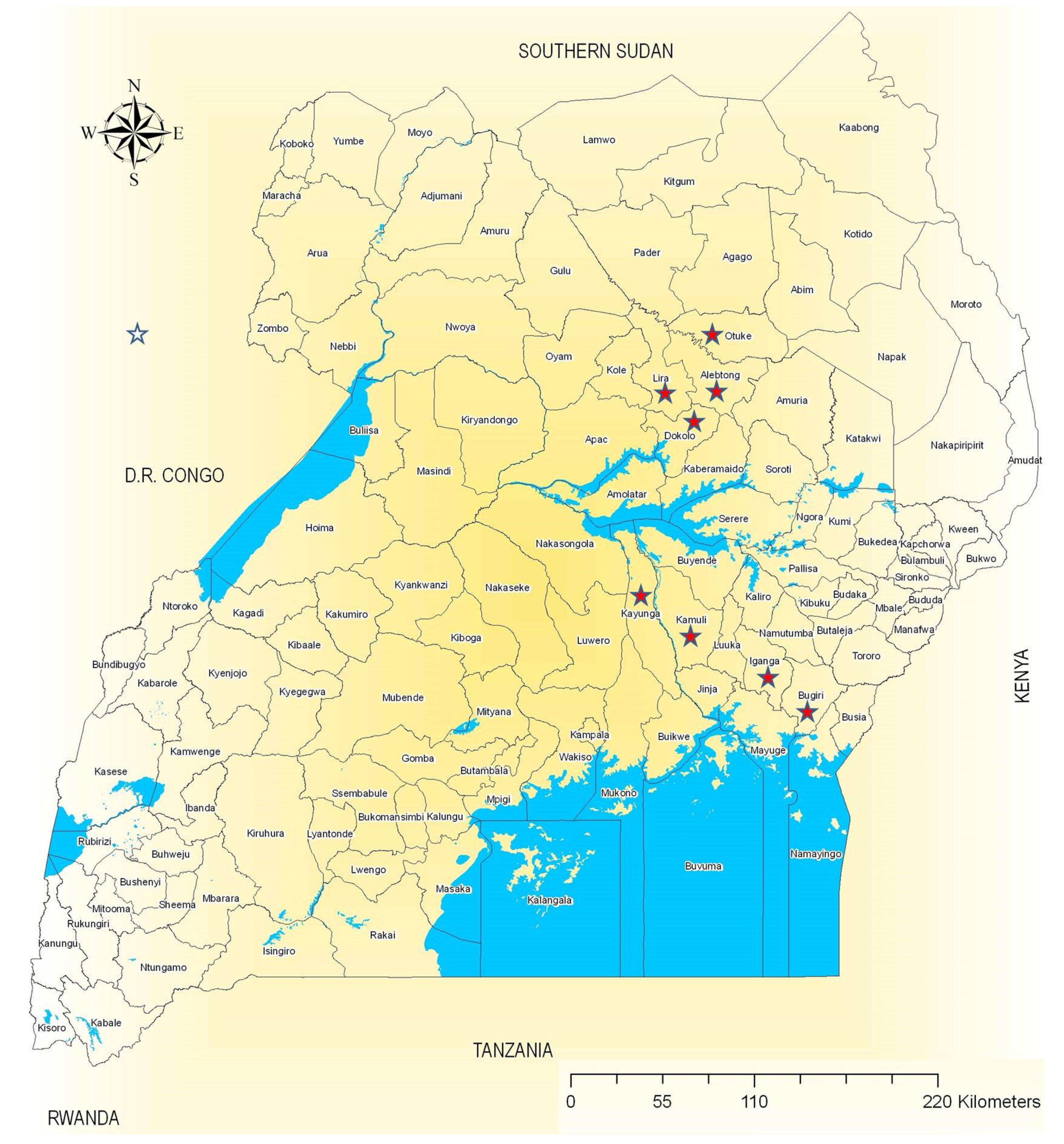
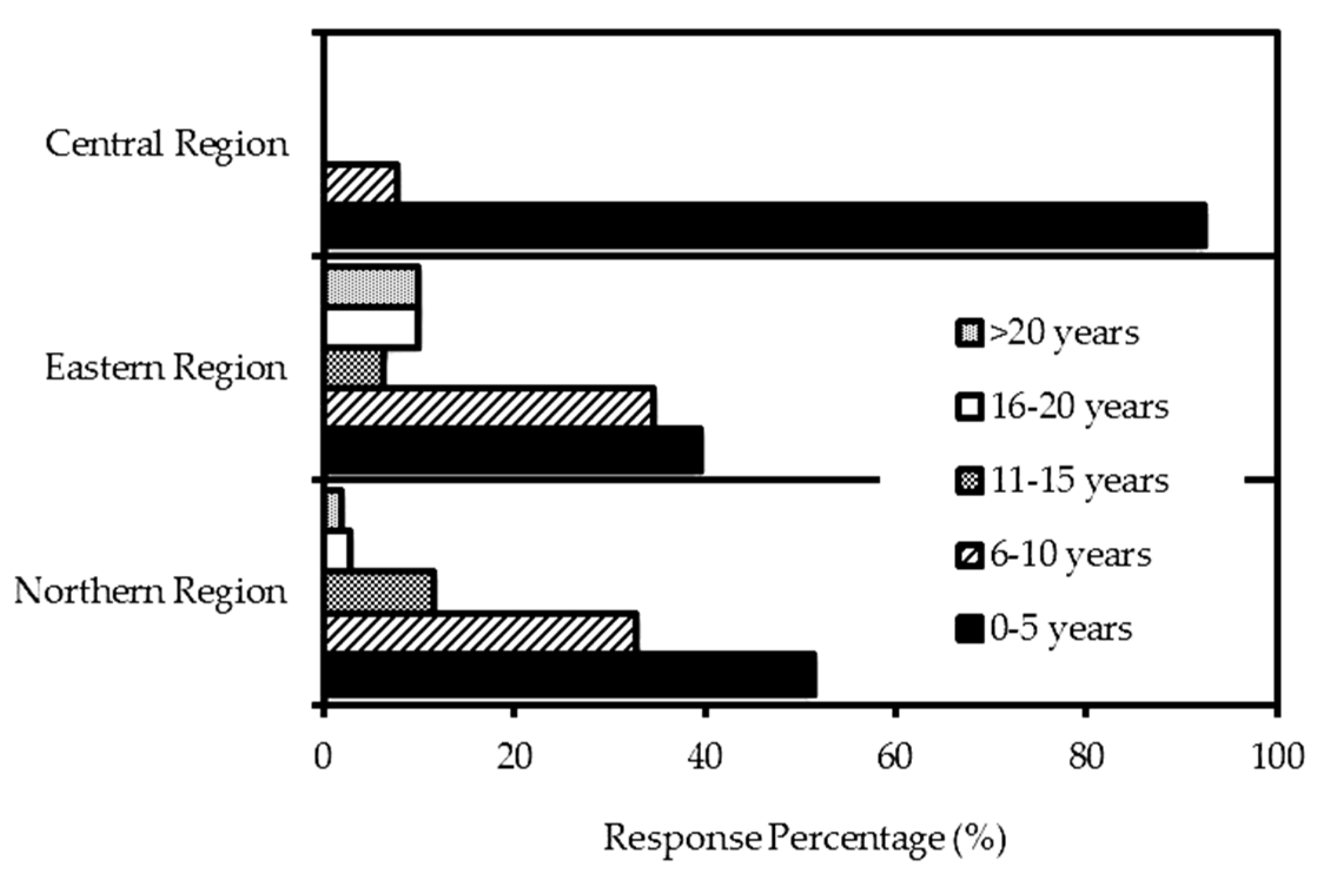
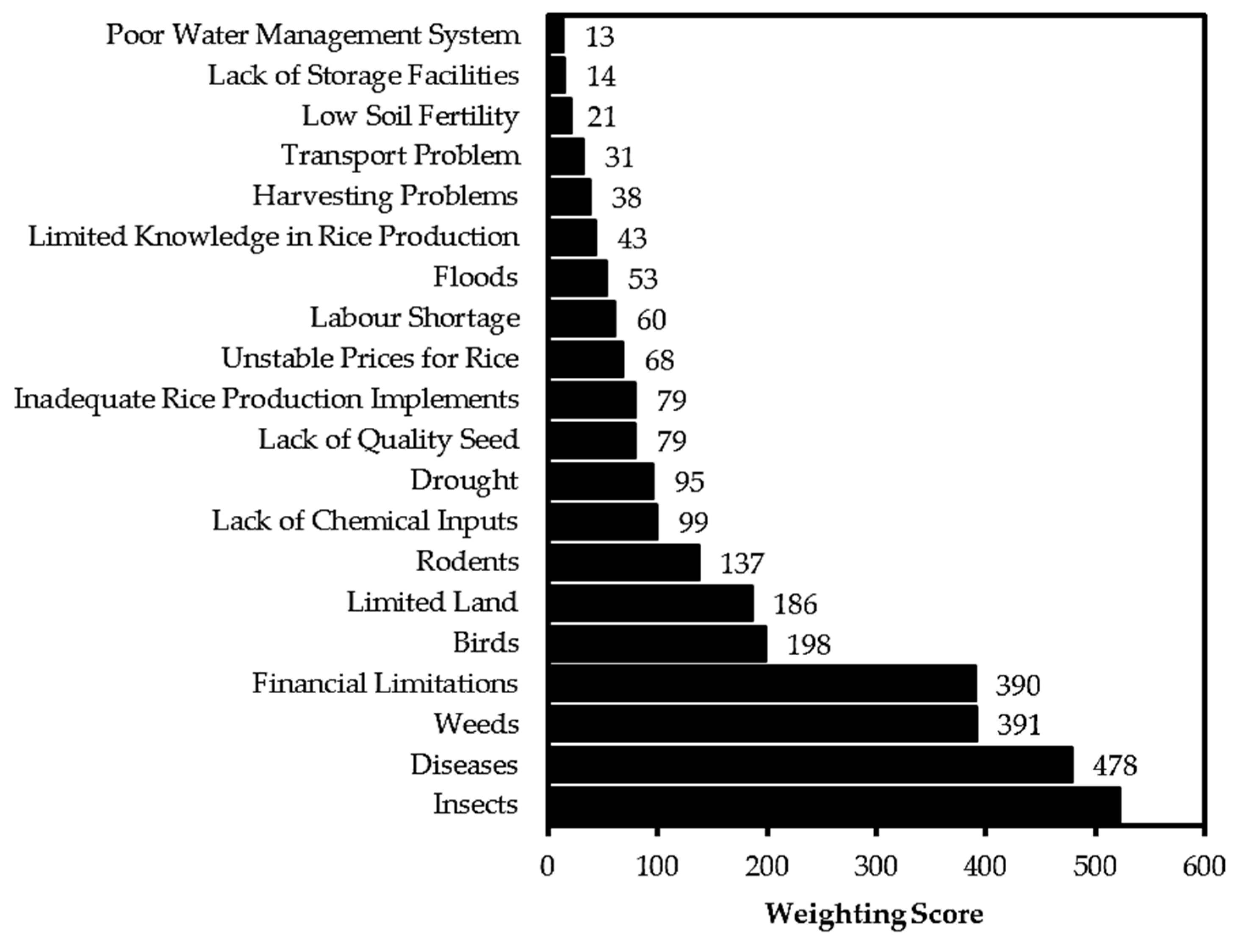
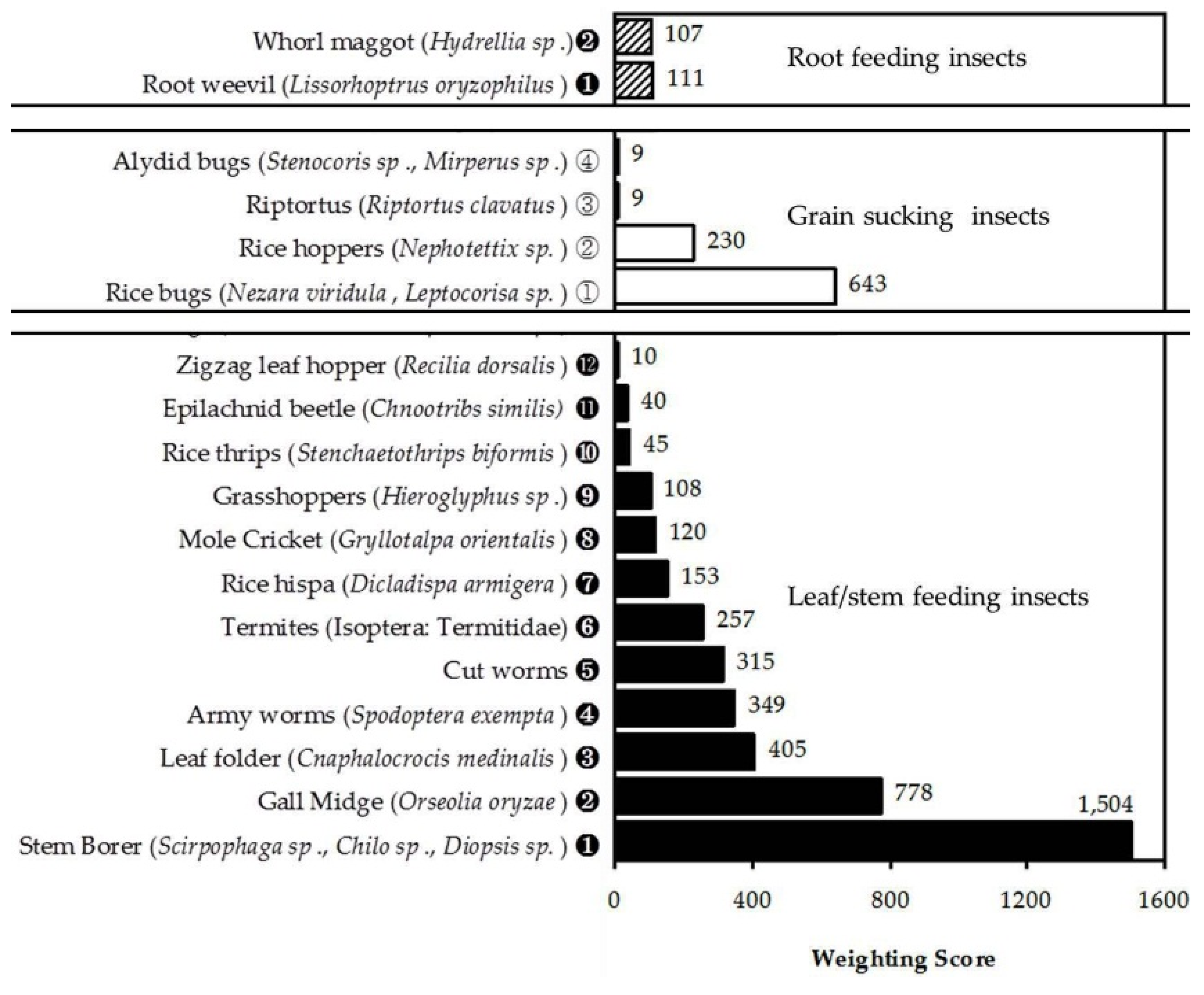
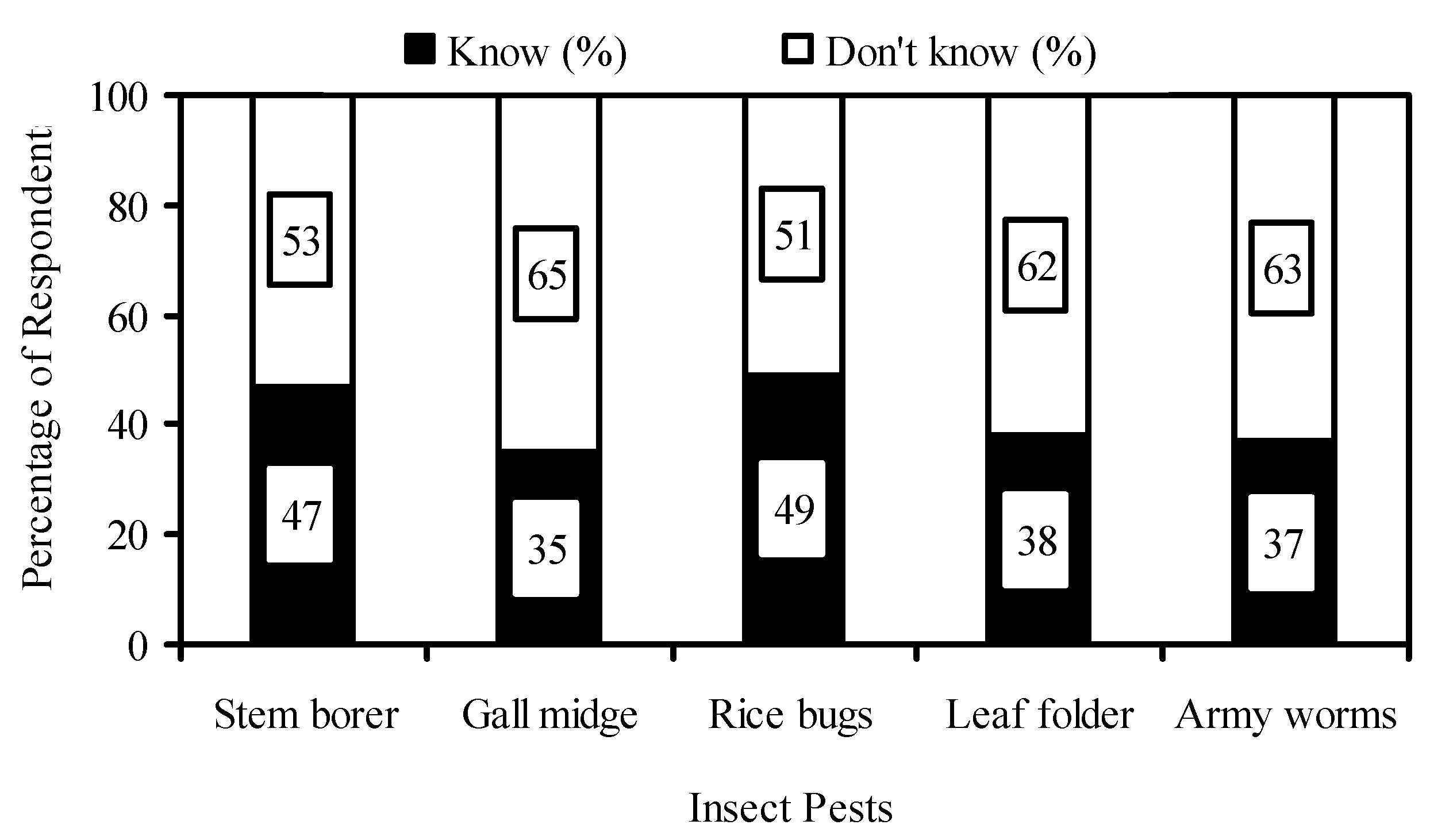
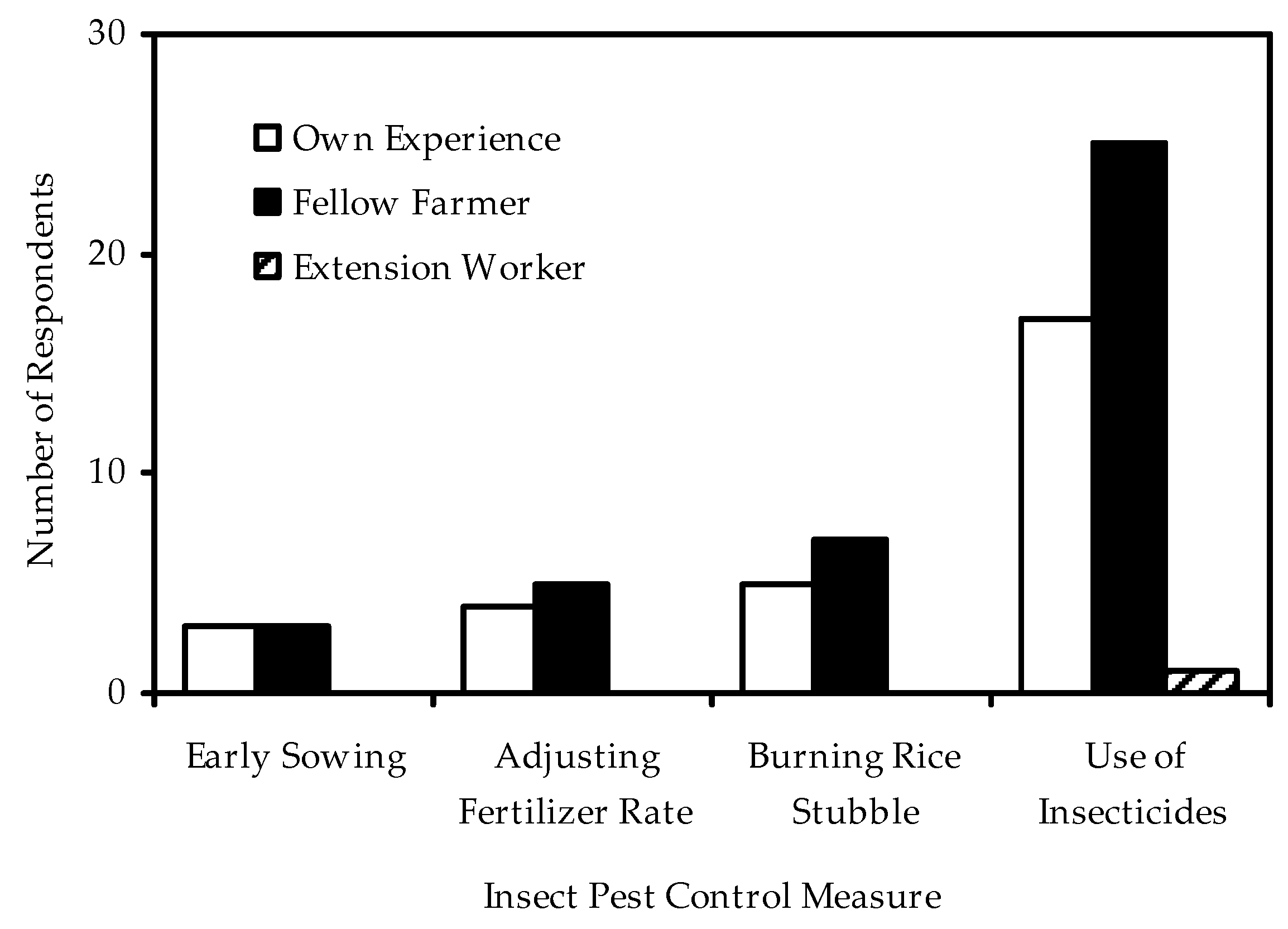
| Characteristics | Summary of Responses | |
|---|---|---|
| Response Frequency (n) | Response Percentage (%) | |
| Sex | ||
| Female | 69 | 30.8 |
| Male | 155 | 69.2 |
| Age (years) | ||
| 18–30 | 68 | 30.6 |
| 31–40 | 69 | 31.1 |
| 41–50 | 50 | 22.5 |
| 51–60 | 29 | 13.1 |
| >60 | 6 | 2.7 |
| Level of Education | ||
| No Education | 29 | 12.9 |
| Primary | 138 | 61.6 |
| Secondary | 54 | 24.1 |
| College/University | 3 | 1.3 |
| Region | District | Average Land Holding (Acres) | |
|---|---|---|---|
| By District | By Region | ||
| Northern | Lira | 5.7 | 8.2 |
| Dokolo | 6.0 | ||
| Otuke | 15.2 | ||
| Alebtong | 5.8 | ||
| Eastern | Iganga | 3.7 | 7.2 |
| Bugiri | 10.5 | ||
| Kamuli | 7.4 | ||
| Central | Kayunga | 3.7 | 3.7 |
| Control Measure | Stem Borer | Gall Midge | Rice Bugs | Leaf Folders | Army Worm |
|---|---|---|---|---|---|
| Response Frequency (%) | Response Frequency (%) | Response Frequency (%) | Response Frequency (%) | Response Frequency (%) | |
| Early Sowing | 3 (13.0%) | 1 (8.3%) | 0 (0%) | 0 (0%) | 0 (0%) |
| Adjusting fertilizer rate | 4 (17.3%) | 1 (8.3%) | 0 (0%) | 2 (33.3%) | 0 (0%) |
| Burning rice stubble | 3 (13.0%) | 1 (8.3%) | 2 (67%) | 1 (16.7%) | 1 (14.3%) |
| Using insecticides | 13 (56.5%) | 9 (75%) | 1 (33%) | 3 (50.0%) | 6 (85.7%) |
| Total | 23 (100%) | 12 (100%) | 3 (100%) | 6 (100%) | 7 (100%) |
© 2016 by the authors; licensee MDPI, Basel, Switzerland. This article is an open access article distributed under the terms and conditions of the Creative Commons Attribution (CC-BY) license (http://creativecommons.org/licenses/by/4.0/).
Share and Cite
Alibu, S.; Otim, M.H.; Okello, S.E.A.; Lamo, J.; Ekobu, M.; Asea, G. Farmer’s Knowledge and Perceptions on Rice Insect Pests and Their Management in Uganda. Agriculture 2016, 6, 38. https://doi.org/10.3390/agriculture6030038
Alibu S, Otim MH, Okello SEA, Lamo J, Ekobu M, Asea G. Farmer’s Knowledge and Perceptions on Rice Insect Pests and Their Management in Uganda. Agriculture. 2016; 6(3):38. https://doi.org/10.3390/agriculture6030038
Chicago/Turabian StyleAlibu, Simon, Michael H. Otim, Stella E. A. Okello, Jimmy Lamo, Moses Ekobu, and Godfrey Asea. 2016. "Farmer’s Knowledge and Perceptions on Rice Insect Pests and Their Management in Uganda" Agriculture 6, no. 3: 38. https://doi.org/10.3390/agriculture6030038
APA StyleAlibu, S., Otim, M. H., Okello, S. E. A., Lamo, J., Ekobu, M., & Asea, G. (2016). Farmer’s Knowledge and Perceptions on Rice Insect Pests and Their Management in Uganda. Agriculture, 6(3), 38. https://doi.org/10.3390/agriculture6030038






